21 AUG 2016 KAJILI TEEJ
Teej Puja Process
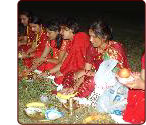 Teej Puja is a vital part of Teej celebration. Women, both married and unmarried, start preparing for the final puja well in advance. The verve, enthusiasm and devotion is apparent on their face. On the puja day, women wear new and beautiful clothes. This is the day to look best of all. Teej Puja is not a very long affair. Women read aloud the Teej Katha and offer their worship to Goddess Parvati.
Teej Puja is a vital part of Teej celebration. Women, both married and unmarried, start preparing for the final puja well in advance. The verve, enthusiasm and devotion is apparent on their face. On the puja day, women wear new and beautiful clothes. This is the day to look best of all. Teej Puja is not a very long affair. Women read aloud the Teej Katha and offer their worship to Goddess Parvati.
Lot of activities and rituals are performed at the time of Teej Puja. Attired in traditional sarees and lehangas, women congregate in a temple to worship Parvati Ma, who took 108 births to reunite with Lord Shiva. On this day, idol of Goddess Parvati is bedecked with rich silk cloth and heavy jewelry. This day is considered very important as married women and engaged girls observe fast for long and healthy life of their husband and to-be-husband.
Teej Puja Process
Women either gather at a nearby temple or a garden where the puja is arranged. The main puja takes place with holy offerings of flowers, sweets and coins. A semi-circle is created and an idol of Goddess Parvati is kept in the middle. A pujarin or all the ladies together narrate the holy Teej Katha. Young girls also sit to listen the auspicious katha. While listening to the katha, women are expected to put their mind and thoughts towards their soul mate.
When the puja gets over women offer fruits, flowers and other holy items and seek blessings of Goddess Parvati for marital bliss. Another very important part of Teej Puja is the oil lamp which should be kept alight throughout the night as it is bad omen if it dies away.
At some places, after paying homage to Goddess Parvati, women bath with red mud found on the roots of the sacred Datiwan bush. This is an act of purification. It is believed that a woman is absolved from all sins after taking this holy bath.
At the end of the day, women share their happiness and joy by dancing and singing traditional songs in praise of Lord Shiva and her consort Parvati.
Significance of Teej
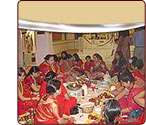 Rooted deep in Indian religious and cultural ethos - Teej plays a significant role in defining the true nature of relationship between a married couple. Besides, the festival provides much needed break to womenfolk from their daily household drudgery. Find out how Teej is significant in these and more ways to the women in India.
Rooted deep in Indian religious and cultural ethos - Teej plays a significant role in defining the true nature of relationship between a married couple. Besides, the festival provides much needed break to womenfolk from their daily household drudgery. Find out how Teej is significant in these and more ways to the women in India.
Religious significance of Teej festival lies in devotion of Goddess Parvati for her husband Lord Shiva. It was on this day that the divine couple Lord Shiva and Goddess Parvati reunited with each other after hundreds of years. Even today womenfolk commemorate this mythological event by observing 'Nirjara Vrat' for the well-being and long-life of their husband.
Climatic Significance
Teej celebrates the advent of monsoon season. Teej coincides with monsoon season and thus create a greater impact for its celebration. Taking full advantage of the beautiful climate at this time women enjoy themselves by swinging, singing and dancing in rain.
Break from Daily Humdrum of Life Teej celebration has great significance for womenfolk as it gives them their much needed break from the daily humdrum of life. For married women it also brings a chance to visit their parents house and relive childhood memories. No wonder, women celebrate the festival with great mirth and enthusiasm. They pay special attention to their appearance and deck themselves in beautiful clothes and fine jewelry. Women also apply intricate patterns of mehndi on their hands and feet.
Strengthening Relationships
One of the foremost significance of Teej is that it helps in strengthening relationship between married couples. Women who observe fast for the long life of their husband in earnest devotion feel closer and more committed to their husband. While watching their wife straining themselves, husbands feel more special. They reciprocate by being more loving and caring towards their wife. Husbands usually express themselves by presenting gifts to their wife and being more sensitive towards their doting wives.
Teej Customs and Rituals
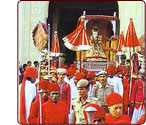 Just as in the case of several other Hindu festival, many traditions and rituals are associated with Teej celebrations. On Teej, women keep fast and perform other customs for long and healthy life of their husband. Every ritual has its own significance and so ladies perform all Teej customs with extreme devotion. Women start preparing for Teej well in advance and go out shopping to bring all the items used in performing Teej rituals.
Just as in the case of several other Hindu festival, many traditions and rituals are associated with Teej celebrations. On Teej, women keep fast and perform other customs for long and healthy life of their husband. Every ritual has its own significance and so ladies perform all Teej customs with extreme devotion. Women start preparing for Teej well in advance and go out shopping to bring all the items used in performing Teej rituals.
Teej customs and rituals make the festival more interesting and full of colors. Women who observe fast for their husband take proper care that no carelessness is committed while carrying out the rituals. Teej festival calls for performance of all rituals seriously if one wants to be blessed with marital bliss.
Shrinjhara
To celebrate the auspicious occasion of Teej, women perform some serious rituals. It is customary for married women to return to their parents' home at the time of Teej. Married women and engaged girls get lot of presents from their father-in-law as per Teej customs. A traditional gift package called 'Shrinjhara' or 'Sindhare' is gifted to their daughter-in-law. This traditional name originated from the Hindi word shringaar meaning adornment. Shrinjhara package consists of Ghewar (sweet), traditional laheria dress (tie & dye), henna and lac bangles. All these items are used by the ladies to adorn herself.
Baya
Baya is another traditional package given to women observing fast on Teej. It includes dry fruits, mathris, new clothes, bangles and jewelry. It is given by mothers of the newly wed girls on the Teej Festival day.
Tradition to Adorn Oneself
On Teej, both married and unmarried girls dress up in traditional colored clothes. Women are usually seen in auspicious red, green and yellow colored lehangas, suits and sarees. Women start shopping for Teej well in advance. It gives them the opportunity to look beautiful of all.
Mehandi and Alta
The most important ritual is to beautify hands with special mehandi designs and alta. Girls and women apply intricate patterns of alta and mehandi to their hands and feet. This is also a part of Teej Shringar. Women usually hide name of their love in these mahendi designs and later ask them to find out their name. This tradition becomes a playful activity and adds vigor to the day's celebration.
Jewelry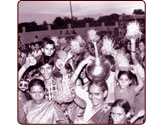 Ladies also wear new gold and diamond jewelry. Some women wear very heavy jewelry while some wear light jewelry. Women have full liberty to ask for anything they wish. Even their husband do not stop them from doing anything and gift them whatever they desire as they starve themselves for well-being of their husband.
Ladies also wear new gold and diamond jewelry. Some women wear very heavy jewelry while some wear light jewelry. Women have full liberty to ask for anything they wish. Even their husband do not stop them from doing anything and gift them whatever they desire as they starve themselves for well-being of their husband.
The most important ritual of Teej Festival is Teej Fast. Women and unmarried girls keep fast for long and healthy life of their husband. Teej fast goes for 24 long hours. It is the most rigorous fast in which a woman neither drinks nor eat.
Tradition of Lighting a Lamp
As per the ritual of Teej fasting, a woman should keep an oil lamp lit all night. If the oil lamp dies away, it is considered a bad omen.
Goddess Parvati
The most important ritual of Teej is to bedeck Parvati Mata and carry out auspicious processions on the streets. Idol of Goddess Parvati is decorated with fine jewelry and new colorful clothes. The fasting day of Teej is very vital as women pray to Goddess for marital bliss and happy life.
Swings
Last but not the least, swings are the common sight when Teej is near. Beautifully decorated swings are hung from trees in the garden and gaily dressed up women swing and sing traditional Teej songs. Some women also dance while singing the holy songs.
Legends Behind Teej
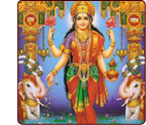 Teej is a major festival of women. It is celebrated every year in the month of July-August with great enthusiasm and verve. Festival of Teej dedicates the day's celebration to Goddess Parvati. The festival's theme is the devotion of women towards their husbands or to-be-husbands. Married and unmarried women adorn themselves to their best and pray for long life of their husband. Though Teej celebrates the advent of monsoon but there is a legend associated with it which makes the day more auspicious.
Teej is a major festival of women. It is celebrated every year in the month of July-August with great enthusiasm and verve. Festival of Teej dedicates the day's celebration to Goddess Parvati. The festival's theme is the devotion of women towards their husbands or to-be-husbands. Married and unmarried women adorn themselves to their best and pray for long life of their husband. Though Teej celebrates the advent of monsoon but there is a legend associated with it which makes the day more auspicious.
One of the most popular legend of Goddess Parvati led to Teej celebrations and women's devotion towards their husband.
Legend of Goddess Parvati
Teej celebrations originated from an age-old legend of Goddess Parvati. Hindu mythology states that Goddess Parvati reunited with Lord Shiva on this day. She went through hard-core tapasya or penance and took 108 births on the earth. The myth also states that she failed to have Lord Shiva as her husband till 107th birth. In her 108th birth, Lord Shiva realized her devotion and love for him and accepted as his wife.
It is said Goddess Parvati declared this moment to be highly auspicious for womenfolk and proclaimed that whoever invokes her on this day will be blessed with happy married life and whatever one desires. Women observe nirjala vrat and spend sleepless nights during the three day festival. This is symbolic to the penance which Goddess Parvati went through.
At the time of Teej, women dress up like a newly wed. They wear green, red and yellow attires, decorate their hands and feet with fascinating mehndi designs and sing devotional songs on Goddess Parvati and Lord Shiva. Women express their happiness, thank and pray God for marital bliss.
Teej Celebrations
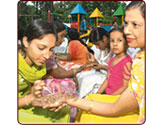 Teej celebrations takes place in various parts of Rajasthan, Punjab and Gujarat. Being an important women festival, Teej is celebrated with full verve and enthusiasm. It is held to mark the advent of monsoon season and also a very important festival for engaged and married women. On this day, women pray to Goddess Parvati for long and healthy life of their husband. There are many activities performed by women to celebrate the holy festival of Teej. Women feel immense pleasure in celebrating the festival and make various preparations before hand.
Teej celebrations takes place in various parts of Rajasthan, Punjab and Gujarat. Being an important women festival, Teej is celebrated with full verve and enthusiasm. It is held to mark the advent of monsoon season and also a very important festival for engaged and married women. On this day, women pray to Goddess Parvati for long and healthy life of their husband. There are many activities performed by women to celebrate the holy festival of Teej. Women feel immense pleasure in celebrating the festival and make various preparations before hand.
Teej commemorates the reunion of Lord Shiva and Goddess Parvati. It is believed that Goddess Paravati took 108 births to have Lord Shiva as her husband. Since then it is proclaimed that who so ever worships Parvati Ma is blessed with happy married life. At the time of Teej, women observe Nirjara Vrat so that Goddess Parvati becomes happy and bless their husband with long and healthy life.
How is Teej Celebrated?
Teej is celebrated in a very colorful way. Women start preparing for Teej a week before the festival. For Teej celebration, women buy new clothes, jewelry and accessories to wear on the festival day. Markets are usually crowded with women shopping for various items to adorn oneself. On Teej, women try to look as beautiful as they can. Intricate mehndi designs are also applied to hands and feet. On the main Teej day, women even visit beauty parlors. Women spend a lot of money of Teej preparations. Even husbands do not say anything to their wife and help them in festival preparations.
Teej celebrations are not only confined to the women celebrating the festival. Teej celebrations take place round the city. A special Teej procession is organized in which the bedecked idol of Goddess Parvati is kept on a palanquin and carried out in the procession. Numerous artists, performers, band members and folk dancers follow the procession showing their magnificent skills. People dance down the streets along with other performers as they completely engross in Teej festivities.
Apart from this, women love to celebrate the festival by making their own special arrangements. Beautifully decorated swings are hung from trees and attractively dressed women dance and sing various Teej and Sawan songs. Fragrance of flowers on Teej swings pervade the atmosphere. After this, women offer prayers to Parvati Mata and the Teej Vrat successfully completes.
At the end of the day, husbands come to pick their wife and sometimes even bring presents for them. This way Teej Celebrations bring lot of happiness for both married and unmarried couples and create some everlasting memories.
Teej Mata – Goddess Parvati
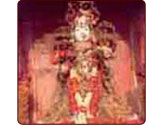 Teej honors Goddess Parvati – symbol of utter devotion and love. Hence Teej is also called Teej Mata Festival. Both married and unmarried Hindu women observe the three-day-long festival seeking blissful married life and happiness for their husband. Teej festivities and its celebrations are dedicated to Goddess Parvati this is why it's purely a festival of womenfolk.
Teej honors Goddess Parvati – symbol of utter devotion and love. Hence Teej is also called Teej Mata Festival. Both married and unmarried Hindu women observe the three-day-long festival seeking blissful married life and happiness for their husband. Teej festivities and its celebrations are dedicated to Goddess Parvati this is why it's purely a festival of womenfolk.
Goddess Parvati
The divine figure of Goddess Parvati is worshiped with earnest dedication at the time of Teej. The day's celebration has an ancient legend associated with it. It is said on this day Goddess Parvati reunited with her consort Lord Shiva. Mata Parvati went through rigorous fasting and a penance of 100 years. She took 108 births to be accepted by Lord Shiva in the form of his wife. Even today the auspicious day is celebrated to honor Goddess Parvati for her true love and positive spirit. And since the celebration of Teej totally relate to Goddess Parvati, so she is also called Teej Mata.
Procession of Teej Mata
On the last day, Teej idol is taken out from the pat (holy place where she is kept). The idol is freshly painted and bedecked with pure gold and other fine jewelry. Bright colors are used to decorate the Goddess. The idol is offered fruits, milk, chapati, nookti, ghewar and pure jal by saints performing prayers and chanting holy shlokas.
Teej idol covered with a canopy is taken out in the procession. Specially decorated 'band baaza' with a team of performers precede the procession. The 'Teej Mata Palki' or 'Takht-e-Rawan' is carried by 8 men dressed in red color. In the Pink City of Rajasthan, Jaipur where grand celebrations for Teej takes place carries out Teej Mata in a royal procession from the city palace so that the general public can pay homage to the festival Goddess and get their desires fulfilled.
In the Teej Mata procession there are around 10-12 elephants, 16 well-adorned horses and performers including dancers, singers and folk-artists. Beautifully decorated camels and bullock carts are an added attraction to the festival procession. Bhog is also given to the devotees who come closer to pay homage to the deity.
There is a huge rush to have a single glimpse of Teej Mata Palki. People in colorful traditional dresses even reach the top of houses and tree tops to have a splendid view of the holy procession. As the procession moves forward people keep offering precious ornaments to the idol. The time when “Mata” is about to reach back its place, the idol gets almost covered with gold and silver jewelry.
Teej Puja Process
 Teej Puja is a vital part of Teej celebration. Women, both married and unmarried, start preparing for the final puja well in advance. The verve, enthusiasm and devotion is apparent on their face. On the puja day, women wear new and beautiful clothes. This is the day to look best of all. Teej Puja is not a very long affair. Women read aloud the Teej Katha and offer their worship to Goddess Parvati.
Teej Puja is a vital part of Teej celebration. Women, both married and unmarried, start preparing for the final puja well in advance. The verve, enthusiasm and devotion is apparent on their face. On the puja day, women wear new and beautiful clothes. This is the day to look best of all. Teej Puja is not a very long affair. Women read aloud the Teej Katha and offer their worship to Goddess Parvati.
Lot of activities and rituals are performed at the time of Teej Puja. Attired in traditional sarees and lehangas, women congregate in a temple to worship Parvati Ma, who took 108 births to reunite with Lord Shiva. On this day, idol of Goddess Parvati is bedecked with rich silk cloth and heavy jewelry. This day is considered very important as married women and engaged girls observe fast for long and healthy life of their husband and to-be-husband.
Teej Puja Process
Women either gather at a nearby temple or a garden where the puja is arranged. The main puja takes place with holy offerings of flowers, sweets and coins. A semi-circle is created and an idol of Goddess Parvati is kept in the middle. A pujarin or all the ladies together narrate the holy Teej Katha. Young girls also sit to listen the auspicious katha. While listening to the katha, women are expected to put their mind and thoughts towards their soul mate.
When the puja gets over women offer fruits, flowers and other holy items and seek blessings of Goddess Parvati for marital bliss. Another very important part of Teej Puja is the oil lamp which should be kept alight throughout the night as it is bad omen if it dies away.
At some places, after paying homage to Goddess Parvati, women bath with red mud found on the roots of the sacred Datiwan bush. This is an act of purification. It is believed that a woman is absolved from all sins after taking this holy bath.
At the end of the day, women share their happiness and joy by dancing and singing traditional songs in praise of Lord Shiva and her consort Parvati.
Kajli Teej Vrat Katha
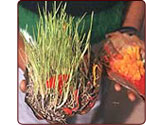 To celebrate the auspicious occasion of Teej, women fast for longevity and healthy of their husband. They refrain themselves from water and food whole day and perform various rituals associated with the festival. In the evening a special Vrat (fast) katha is chanted. These are stories based on Hindu legends which are narrated to ladies who gather to conclude their fast ceremony. Teej Vrat Katha is very crucial feature of Teej celebrations.
To celebrate the auspicious occasion of Teej, women fast for longevity and healthy of their husband. They refrain themselves from water and food whole day and perform various rituals associated with the festival. In the evening a special Vrat (fast) katha is chanted. These are stories based on Hindu legends which are narrated to ladies who gather to conclude their fast ceremony. Teej Vrat Katha is very crucial feature of Teej celebrations.Teej Fast
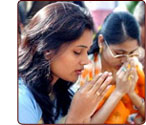 The holy custom of fasting form an integral part of Teej celebrations. Hence Teej is also famous as 'women fasting festival'. For full 24 hours women refrain themselves from food and water to ensure long life of their husband. The tradition to fast for so long without water and food has a pious legend associated with it. According to Hindu mythology, Goddess Parvati underwent penance for 100 years to be accepted by Lord Shiva. Even till date women pay homage to Goddess Parvati and seek blessings for blissful marital life.
The holy custom of fasting form an integral part of Teej celebrations. Hence Teej is also famous as 'women fasting festival'. For full 24 hours women refrain themselves from food and water to ensure long life of their husband. The tradition to fast for so long without water and food has a pious legend associated with it. According to Hindu mythology, Goddess Parvati underwent penance for 100 years to be accepted by Lord Shiva. Even till date women pay homage to Goddess Parvati and seek blessings for blissful marital life.
Teej fast is widely popular in Northern as well as North-West region. Tradition of Teej fasting is obligatory for women belonging to Kayastha community.
Pre-Fasting Day of Teej
Teej fast is 24 hour-long and begins immediately after the first day of Teej. It is a pre-fasting day on which ladies gather to sing and dance. Mothers, grandmothers, sisters and daughters sit together to have a lavish feast because the rigorous fast begins at midnight. Married women keep fast for healthy life of their husband while unmarried girls keep it to marry a person who good and understanding. Women dress up in red colored clothes as it is associated with Hindu married women. One can see this holy scene every year as devotional women prepare themselves to undertake a day-long fast and prayers only for their husband.
Teej Fast – An Arduous One
Teej fast is a difficult one as women restrict themselves even from a morsel of food and drop of water for full 24 hours. Many women face health problems because of this.
It is especially very difficult for the newly wed women to keep the 24-hour-long fast without eating and drinking anything. One needs lot of patience and courage to keep such a long fast. Usually mother-in-law encourages their sweet bahus to drink juice or tea so that they don't fall sick on such an auspicious occasion.
Pregnant ladies are advised not to keep the fast and even if they observe the fast it is advisable to consult a doctor. Many pregnant ladies go on a diet of milk and fruits and fulfill their nutritional requirements.
To pass away the arduous day women also play a lot of games, watch movies and do many other activities to pass their time. Some even go off to sleep and don't involve themselves in any household activity.
After the day-long fast for longevity of their soul mate is over, women drink water and eat some healthy food. Many husbands make their wife drink water with their hands.
Mantra Legend
Real Reviews, Fresh Photos. Book with TripAdvisor & Save MoneyOnline Puja, Japa, Yajna
Rudra Centre is leading brand for Hindu Puja Items & Services
Search Results
Haritalika Teej 2012 date -- Haritalika Vrat - 18-9-2012. - YouTube
https://www.youtube.com/watch?v=Ys7vGNxTu78
Jul 21, 2012 - Uploaded by SindhuSagarDhodyji
Haritalika Teej Vrat is an important Hindu fasting dedicated to ... There is a widespread belief that by observing ...Hartalika Pooja (Promo Video) - YouTube
https://www.youtube.com/watch?v=ngZdKsxKV18
Aug 18, 2014 - Uploaded by Sonic Octaves
Hartalika Pooja (Promo Video) ... Hartalika Teej Par Vrat, Puja Ka Sampurn Vidhan Tatha Shastriya ...Kaise Kare Shree Ganesh Chaturthi Vrata Aur Puja, Sampurn Vidhan ...
https://www.youtube.com/watch?v=YY6_lA195As
Oct 11, 2014 - Uploaded by Vaibhava Nath Sharma
Kaise Kare Shree Ganesh Chaturthi Vrata Aur Puja, Sampurn Vidhan ... Top 16 - "Ganesh Puja ...Navki Bahuriya Khada Badi Hathe Jod Ke Singer : Bharat Sahni Bagi ...
https://www.youtube.com/watch?v=1cU510UUdq0
Oct 29, 2014 - Uploaded by Damodar Raao
Navki Bahuriya Khada Badi Hathe Jod Ke Singer : Bharat Sahni ... It is believed that Large no of Gods ...How to do Vat Savitri Vrat - YouTube
https://www.youtube.com/watch?v=Wf-aVrv2_lU
May 20, 2013 - Uploaded by Festivals n Culture
Vat Savitri Vrat falls in the Hindu Month of Jeshtha ( May-June ) on the new ... like Mangala Gauri , Tritiya ...TEEJ celebration - Jaipur
www.pinkcity.com/author/neelam/feed/
Jul 30, 2012
Jaipur personifies the rich culture and royal traditions that depict the cultural heritage of Rajasthan. .... keeping ...
Stay up to date on results for kajari teej puja rituals legend aarti mantra.
Create alertSearch Results
Hariyali Teej celebration with Indian rituals - Pandit.com
www.pandit.com › Hindu Festivals
What is Hariyali Teej? Hariyali Teej is a festival in which fasts are kept by Indian women. ... This is the legend behind festival of Hariyali teej. ... hariyali-teej-puja.Hartalika Teej 2016 Date - Hartalika Teej 2016 - Hartalika Teej Vrat ...
www.astrosage.com › Festival › Teej
Apr 26, 2016 - Hartalika Teej Vrat Katha is recited on this day. ... According to Hindumythology, Hartalika Teej is believed to be the day of union of Lord Shiva ... Now, we will discuss the rituals and traditions associated with the day of Hartalika Teej. ... Following are the lines that are collectively known as Shanti Mantra:.Teej Puja Process,Teej Puja Rituals,Process of Teej Festival Pooja ...
www.teejfestival.org/teej-puja-process.html
Teej Puja Process - Details about teej puja process, teej puja rituals, process of teej ... teej, teej fast, teej customs, hartalika teej, kajli teej, haryali teej, kajrari teej,
Missing: aarti mantra
Teej Customs and Rituals
www.teejfestival.org/teej-customs-and-rituals.html
Teej Customs & Rituals - Details about teej customs, teej rituals, teej festival ... teej in india, teej celebrations, teej, teej fast, teej pooja process, hartalika teej, kajli ...
Missing: aarti mantra
hartalika teej pooja samagri list | Info 24 World
info24world.com/tag/hartalika-teej-pooja-samagri-list/
Mar 23, 2016 - According to the legend of Hartalika Teej, the friend of Goddess Parvati ... hartalika teej 2015 quotes hartalika teej recipes hartalika teej rituals, hartalika teej... hartalika teej maharashtra, hartalika teej mantra, hartalika teej meaning, ...hartalika teej vrat aarti, hartalika teej sms and wishes, hartalika teej katha ...Teej - Wikipedia, the free encyclopedia
https://en.wikipedia.org/wiki/Teej
Teej (छत्तीसगढ़ी : तीजा (Devanagari) (Nepali: तीज); (Punjabi: ਤੀਜ (
Missing: aarti mantra
Teej Vrat Katha - Free All Music
megafreepop.info/wav_teej_vrat_katha.html
Haritalika teej vrat katha | Teej Vrat Katha | Hartalika fast story in Hindi MP3 ...hartalika puja aarti, hartalika puja marathi, hartalika puja mantra, Hartalika Pujan Va ... Vrata, Religion (TV Genre), katha, story, legends, Haritalika, Puja, Rituals, ...23 MAR 2016 HOLI LEGEND_MANTRA | heve - wixsite.com
bcpat02.wixsite.com/heve/.../23-MAR-2016-HOLI-LEGENDMANTRA
Mar 25, 2016 - Holi Puja Vidhi and Mantra BY BHAKTIRAS · MARCH 13, 2016 Download PDF Holi ... Holi Puja or Holika Dahan is the prime ritual of Holi – the festival of colours2016 Hindu Festival List, Indian Hindu Festivals, Upcoming Hindu ...
www.charanamrit.com/festivals/festival-list
... Bhakti Sangrah (Aarti, Chalisa, Mantra, Katha & Pooja, Jyotirlinga), legend, ... According to Indian Hindu mythology, The month of Shravan has great ... Mangala Gauri Vrat 2016 ... Kajari Teej, also known as Badi Teej is a popular festival for women of North ... The fasting and rituals on the day are dedicated to Ganesha.Hartalika Teej Vrat Katha Va Puja Vidhi Part mp3 Free Download, Play ...
zmp3e.xyz/mp3/hartalika-teej-vrat-katha-va-puja-vidhi-part.html
हरतालिका तीज पर व्रत, पूजा अनुष्ठान, Hartalika Teej Vrat Katha va Puja ... Hartalika Teej ParVrat, Puja Ka Sampurn Vidhan Tatha Shastriya Katha, Story, Legends ... Download: Haritalika Teej Pooja Vidhi Katha and Aarti.mp3 .... Ke Kis Din Me Kis Devi ya Devta Ki Kare Puja, Har Devta Ki Puja Vidhi Va MantraSearches related to kajari teej puja rituals legend aarti mantra
Dahisar West, Mumbai, Maharashtra - From your search history - Use precise location
No comments:
Post a Comment